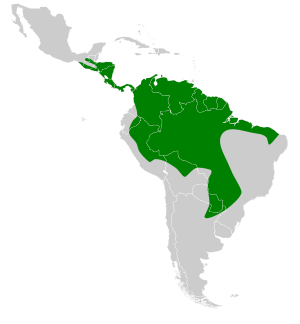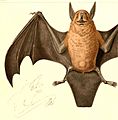Lesser bulldog bat facts for kids
Quick facts for kids Lesser bulldog bat |
|
|---|---|
 |
|
| Conservation status | |
| Scientific classification | |
| Genus: |
Noctilio
|
| Species: |
albiventris
|
 |
|
The lesser bulldog bat (Noctilio albiventris) is a fascinating bat that mainly eats insects. Sometimes, it also eats small fish. These bats live in Central America and northern South America. They have some special features, like large feet that they use to scoop up prey from the water's surface. They also use a very precise method of echolocation to find their food.
Contents
What Does the Lesser Bulldog Bat Look Like?
Lesser bulldog bats show what's called sexual dimorphism. This means males and females look different. Males are usually a bright red color, while females are typically a dull brown. The colors can also vary a lot between individual bats and even between different groups of bats.
These bats are about three inches (7.5 cm) long, and their forearm is about 2.5 inches (6.35 cm). They weigh around one ounce (30 grams), which is about the same as a slice of bread! Their plump lips and a chin with special ridges make them look a bit like a "bulldog", which is how they got their name. They also have large, claw-like feet that are perfect for catching prey.
Where Do Lesser Bulldog Bats Live?
Lesser bulldog bats prefer to live in places near water or damp areas. You can often find them in hollow trees or even inside buildings. They live in many countries, including Argentina, Belize, Bolivia, Brazil, Costa Rica, Ecuador, El Salvador, French Guiana, Guatemala, Guyana, Honduras, Mexico, Nicaragua, Panama, Paraguay, and Peru.
How Do Lesser Bulldog Bats Find Food?
These bats mostly eat insects, which they catch while flying low over water. They are very skilled at this! Some studies in Costa Rica have also shown that these bats might eat tree pollen sometimes.
How Do Lesser Bulldog Bats Use Echolocation?
Noctilio albiventris is famous for using echolocation to find its prey, especially insects. Echolocation is like using sound to "see" things. Here's how they do it: As they fly just above the water, they send out special sounds. When these sounds hit something, like an insect on the water's surface, the sound waves bounce back. The bat then detects this change in the sound and knows exactly where to go to catch its meal.
Since lesser bulldog bats often hunt in small groups, they also use echolocation to talk to each other while they are looking for food. This helps them work together.
Life Cycle of the Lesser Bulldog Bat
Lesser bulldog bats can live for about ten years. They become old enough to have babies when they are about one year old. After a female bat gets pregnant, the baby bat grows inside her for about 4 to 5 weeks.
When baby bats are born, they can only make very quiet sounds. They can't fly until they are about 5 to 6 weeks old. Mother bats take good care of their young, feeding them milk until the babies are about three months old.
Who Are the Predators of the Lesser Bulldog Bat?
It's not very common for bats to be hunted, but some large birds do prey on them. One bird that is known to hunt the lesser bulldog bat is the Great Rufous Woodcreeper. This bird will actually go into the bats' roosting spots (where they sleep) and grab a bat. The woodcreeper then uses its sharp beak to peck the bat until it dies. Other animals that might hunt lesser bulldog bats include hawks, falcons, owls, and motmots.
Gallery
-
Noctilio albiventris diagram from Alcide Dessalines d'Orbigny
See also
 In Spanish: Murciélago pescador de vientre blanco para niños
In Spanish: Murciélago pescador de vientre blanco para niños
- Bulldog bat
- Microchiroptera




